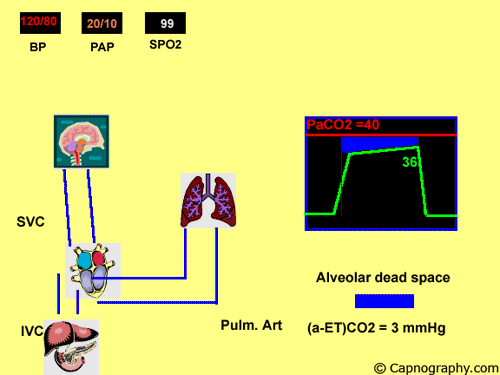Clinical Aspects
Detection of pulmonary air embolism
A rapid decrease of PETCO2 in the absence of changes in blood pressure, central venous pressure and heart rate indicates an air embolism without systemic hemodynamic consequences.1,2 However, as the size of air embolism increases, a reduction in cardiac output occurs which further decreases PETCO2 measurement. A reduced cardiac output by itself can decrease PETCO2. Therefore, in the event of a rapid decrease in PETCO2

Drummond et al3 defined the relative sensitivities of end tidal carbon dioxide analysis, end-tidal nitrogen analysis, and pulmonary artery pressure (PAP) monitoring in detection of venous air embolism (VAE) in a study. Serial injections of air (0.25, 0.5, 0.75, 1.0, and 1.5 ml/kg) were performed in six mongrel dogs. The frequency with which positive responses (PAP increase >2 mm Hg; ETCO2 decrease >0.2%; ETN2 increase 0.04%) were observed following VAE) was not different for three methods. However, the response time (time to maximum following VAE) was significantly more rapid for PAP and ETN2 than for ETCO2; although the range for the three methods was narrow. The time to return to baseline levels was significantly more rapid for ETN2 and ETCO2 which was in turn significantly faster than PAP.
References:
1. Smelt WLH. Capnography and air embolism. Can Anaesth Soc J 1986;33:113-5.
2. Symons NLP, Leaver HK. Air embolism during craniotomy in the seated position: a comparison of methods of detection. Can Anaesth Soc J 1985;32:17407.
3. Drummond JC, Prutow RJ, Scheller MS. A comparison of the sensitivity of pulmonary artery pressure, end-tidal carbon dioxide, and end-tidal nitrogen in the detection of venous air embolism in the dog. Anesth Analg 1985;64:688-92.

 Twitter
Twitter Youtube
Youtube









